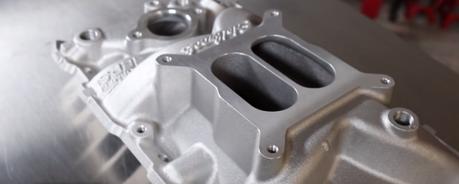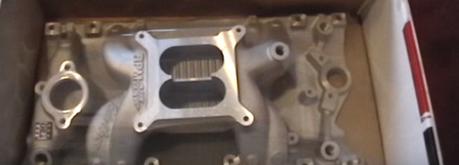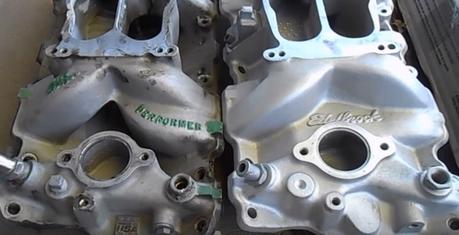The Chevrolet 350 is a small-block V8 engine used in standard production between 1955 and 2003. The name "small block" derives from its size when compared to the larger Chevy engines of the time. The small block engines were a range between 262 cu in (4.3 L) to 400 cu in (6.6 L) in displacement.
While there are many models of the small block, the 350, which was introduced in 1967 became one of the more popular models (together with the 305), and this was then developed and upgraded into both high- and low-output variants across the entire Chevrolet product line.
350's has been discontinued since 2003. However, GM maintains a plant in Mexico that still churns out the 350 for replacement and hot-rodding applications.
Intake Manifold
So, what is an intake manifold? Well, basically it's a lump of metal that is formed to deliver air and fuel to the cylinders set in the engine block. As such, intake manifolds can be simple flow controllers or more complex multi-part holding heads with flow control. For instance, in a carbureted engine, the intake manifold connects the intake ports to the carburetor, and in fuel injected models the intake manifold connects the intake ports to the throttle body.
The more comprehensive models act as an engines cylinder head and cover the cylinders, as such they perform a seal operation which requires precision, gaskets, and materials that do not crack or bend under pressure. Such manifolds will come with coolant tubing allowing the engines coolant system to pass through the manifold as part of the entire cooling system.
Manifolds come in two forms, a flat head or a V shape, and they are now mainly made of cast aluminum alloys, the older ones were made of cast iron. The performance manifolds are made from composite materials and are only usually found on hyper-cars and professional track vehicles.
The name is a derivative of the words "many folds" since it implies that this cast contains many inputs and outputs and channels.
The most basic units will be bolt-on, these are designed to provide an air-tight cover over cylinder heads and are found in flat or straight engines. The V engines have a manifold that comes with a "valley," these are more complex structures, and since the exhaust ports are located on the outside of the V shape, they need to connect with the intake ports that are located on the inside. A such, the structures of V intake manifold must include the ability to hold exposed components such as lifters and pushrods.
Intake Manifold Issues
An intake manifold has two issues that arise over time; these are bad gaskets and cracked manifolds.
Both these issues break the seal of the manifold and allow air to enter the intake system, which eventually leads to engine failure. While it is easy to replace a gasket, and also cheaper, a cracked manifold must be replaced.
While a crack is easier to detect, gasket issues are harder, so before you do go unbolting your manifold, just take a quick look at the vacuum lines and component that are connected to see if the issue of pressure is not sourced elsewhere.
Now let's take a look at the best intake manifold for Chevy 350 "small-block" engines.
List of Top-Rated Intake Manifolds for Chevy 350 Comparison Table:
The Intake Manifolds for Chevy 350 Reviews & Buyer's Guide:
Description
This is the Edelbrock Part # 2701 Performer EPS intake manifold is designed for 1986 350 small block engines.
Performance
This is an all-aluminum alloy Patented Dual-plane, low-rise design that comes with 180-degree firing order. This design greatly improves torque over a wider rpm range and ultimately delivers an excellent throttle response.

This model has a "tuned" runner design delivering peak torque at 3500 rpm; this is ideal to power from off-idle to 5500 rpm.
There is an increase of 5 hp and 9 ft-lbs. of torque that has been Dyno tested.
The carb pad height is set at 4.27", the maximum front height is 3.74," and the rear maximum height is 4.8".
This model is recommended for use with an Edelbrock AVS2 or Performer Series 500-650 cfm carburetor. The port exit dimensions are 1.15″ x 1.87″, and are best suited for an Edelbrock # 7201 intake gasket.

For threads that extend into the lifter valley or coolant passage use a sealant, and use Teflon for the NPT pipe thread fittings. Make sure you don't overtighten the pipe fittings, or you will crack the aluminum around the fitting boss.
Features
- Dual Plane Design
- Will not fit under stock Corvette hood.
- These are compatible with EGR systems.
- Cast Aluminum Alloy
Recommendations
A very inexpensive model, great for slight OEM performance improvements, but all in all a great stock type replacement component.
Description
The Edelbrock Part # 7501 RPM Air-Gap #7501 intake manifold is designed for 1955-86 350 models.
Performance
This air gap model comes with an open-air space separating the runners from the hot engine oil. This leads to improved performance and results in a cooler, denser charge delivering more power.

The carb pad height is set at 4.27", the maximum front height is 4.20," and the rear maximum height is 5.20".
This model is recommended for use with an Edelbrock AVS2 or Performer Series 650-800 cfm carburetor for 192-1978 models use the # 8031 or # 8036 brackets.
The port exit dimensions are 1.14″ x 1.95″, and are best suited for an Edelbrock # 7201 intake gasket.
This model requires the # 8504 Edelbrock bolt kit.
For threads that extend into the lifter valley or coolant passage use a sealant, and use Teflon for the NPT pipe thread fittings. Make sure you don't overtighten the pipe fittings, or you will crack the aluminum around the fitting boss.
Features
- Dual Plane Design
- Will not fit under stock Corvette hood.
- Cast Aluminum Alloy
Recommendations
This is a performance grade model and comes with a heftier price tag than the #2701. However, it's a compact unit and well worth the extra investment.
Description
This is the Edelbrock Part # 2101 Performer intake manifold is designed for street 1955-86 small-block 350 applications.
Performance
This model uses a patented Dual-plane, low-rise design. It comes with 180-degree firing order. As such it improves torque over a wider rpm range that results in excellent throttle response from off-idle through 5500rpm.

The carb pad height is set at 4.05", the maximum front height is 3.50," and the rear maximum height is 4.60".
This model is recommended for use with an OEM 4-Bbl, and for this use the #9171 choke rod. For the 1972-1978 models consider using the Edelbrock AVS2 Series or Performer Series Carb 500-650cfm use the # 8031 or # 8036 brackets.

The port exit dimensions are 1.14″ x 1.88″, and are best suited for an Edelbrock # 7201 intake gasket.
For threads that extend into the lifter valley or coolant passage use a sealant, and use Teflon for the NPT pipe thread fittings. Make sure you don't overtighten the pipe fittings, or you will crack the aluminum around the fitting boss.
This is a performance intake manifold that will work with a vast range of applications using the 350-small block, including passenger cars, trucks, 4x4s, towing and RVs.
Features
- Dual Plane Design
- These are compatible with EGR systems.
- Cast Aluminum Alloy
Recommendations
This is a very versatile intake manifold unit and is actually adaptable to all 350 applications between 1955 to 1986. The price is exactly center, so you don't get to pay over or under the value for performance rating.
Description
This is the Street Warrior™ Intake Manifold non/EGR 262ci-400ci, with Vortec (L31) Cylinder Heads for your 350 small block applications for 1996 - 2002.
Performance
The Weiand intake manifold is made from a Permanent Mold Cast, precision machined aluminum alloy. It delivers in the idle to the 5500RPM band.
The carb pad height is set at 4.05", the maximum front height is 3.375," and the rear maximum height is 4.50".
This is a low-rise model; the port exit dimensions are 2.22″ x 1.06".
Features
- Stock OEM replacement part
- Aluminum alloy casting
Recommendations
This is a Weiand product, so its designed to be as close an exact OEM part as possible. The price is reasonable, well within the range, you would expect from this model.
Description
The Dart 42811000 Dual Plane Intake Manifold for 350 small blocks Chevy, 1955-1986 models
Performance
The Dart intake manifolds use a wet flow technology that was developed from extensive research using the oval track and drag racing vehicles. The Hight of this manifold is 4.27."
The port shape, plenum volumes, and the runner angles are all optimized for performance.
This model uses a dual plane style with improved intake, that comes with long, separated runners for bottom-end and midrange power. You also get a special runner design with the larger plenum for high-rpm horsepower.
This cast aluminum alloy model is for single, square-bore 4-barrels, with a power from idle to 6,000 rpm.
Features
- Recommended for 215cc and smaller intake ports
- Installs with 4150 square carburetors
- Dual distributor hold-downs
- Raised water cross-over and air gap insulate intake charge
- Integral bosses for nitrous injectors
Recommendations
This is an expensive model when compares to the similar brands in the same category. However, it does have some interesting additional features that improve the performance from stock to aftermarket upgrade.
How to install an Intake Manifold
Here's a step-by-step guide based on my experience:
- Start off with a clean engine, so blow the engine with compressed air;
- Prepare all your tools and parts at hands length;
- Start by marking each connection so its easier to reconnect them after completing the installation of the manifold;
- Take heed that older models with original parts can break easily, especially the electrical connections;
- Pull the distributor cap and turn the rotor points straight ahead;
- Take note of the position of the rotor relative to the distributor body. (take a photo);
- Now take out the distributor hold-down clamp and pull the distributor clean off. The rotor will rotate about 20-degrees counterclockwise during this process;
- Now take off all the vacuum lines and sensors from the Q-jet;
- Disconnect the fuel line linkage and remove the fuel line;
- Unbolt the Carburetor bolts and take it out;
- Clean the surface again, use a vacuum this time;
- Now, unbolt all 12 intake manifold bolts;
- Use a screwdriver and loosen the manifold form the gasket;
- Clean all surfaces and prepare for a new gasket;
- Using Permatex gasket sealer, smear it on both sides of the gaskets then install them on the heads;
- Use Permatex silicone on the front and rear china and also put a little silicone under the ends of the gaskets where they meet the china wall;
- Now place the new intake manifold on the heads, and line up the bolt holes;
- Torque in the bolts;
- Return the distributor, start by setting the rotor 20 degrees counterclockwise from straight ahead;
- Install the EGR valve and the carburetor, and reinstall all the pipes, fittings and wires.
All done!
